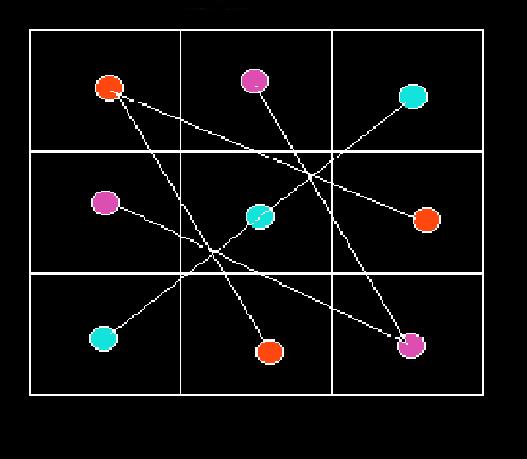

Andrew Bremner's article on squares of squares included the 3x3 square:
| 3732 | 2892 | 5652 |
| 360721 | 4252 | 232 |
| 2052 | 5272 | 222121 |
The numbers in the right diagonal as the triple (2052,4252,5652) seem to have been derived elsewhere. This sequence as well as a host of others has been obtained from a number of web pages starting with PartIA-1 where the first number in the triple when added to a difference (Δ) gives the second square in the triple and when this same (Δ) is added to the second square produces a third square. In other words adding the two sums produces the Diophantine equation: 2y2 − x2 = z2 . The method discovered therefore was useful in generating integers which could be used as the right diagonal entries of a magic square consisting primarily of squares.
The general method for generating the requisite positive or negative triples were again generated using the method of triples and the method is summarized here. Beginning with the triple
The method is easily translatable into a computer program capable of generating a host of Diophantine triplets in a simple, rapid manner without having to resort to guessing at the individual values.
.To obtain e, g and f, where in this case g is now equal to 3e, the algebraic calculations are performed as follows:
Using the transformation equation f we convert the triple (1,1,−1), where a1 = 1, b1 = 1 and c1 = −1 and use the f value into the three, respective equations a, b and c.
Substituting the appropriate n into the equations for a, b, c and using d as the value of the denominator in f produces the table I below as verified by a computer program for the first eleven values of n. As can be seen, taking the value of f from the middle of the table and adding it to a1,b1, c1, produced a, b, c, respectively. The fractional numbers (a,b,c) are then normalized by multiplying each by the value of the current value of d the denominator of the current f and where rounding off is part of the normalization process. Normalization is not a process that is required when g=2e since the denominator of f is equal to one and the values of (a,b,c) are the true ones. In addition, the (a,b,c) values may be regular or inverted where the lowest values may be either first or last. In this case it doesn't matter whether the triple is (a,b,c) or (c,b,a).
| n | a1 | b1 | c1 | d | f | a | b | c |
|---|---|---|---|---|---|---|---|---|
| 0 | 1 | 1 | -1 | 4 | 0 | 1 | 1 | -1 |
| 1 | 1 | 2 | 2 | 2 | -1.500 | -0.500 | 0.500 | 0.500 |
| 1 | 2 | -1 | 1 | 1 | ||||
| 2 | 1 | 3 | 5 | 0 | ∞ | 8† | 8† | 8† |
| 3 | 1 | 4 | 8 | -2 | -16.500 | -15.500 | -12.500 | -8.500 |
| 3 | -2 | 31 | 25 | 17 | ||||
| 4 | 1 | 5 | 11 | -4 | -18.000 | -17.000 | -13.000 | -7.000 |
| 4 | -4 | 68 | 52 | 28 | ||||
| 5 | 1 | 6 | 14 | -6 | -20.833333 | -19.833333 | -14.833333 | -6.833333 |
| 5 | -6 | 119 | 89 | 41 | ||||
| 6 | 1 | 7 | 17 | -8 | -24.000 | -23.000 | -17.000 | -7.000 |
| 6 | -8 | 184 | 136 | 56 | ||||
| 7 | 1 | 8 | 20 | -10 | -27.300 | -26.300 | -19.300 | -7.300 |
| 7 | -10 | 263 | 193 | 73 | ||||
| 8 | 1 | 9 | 23 | -12 | 30.666667 | -29.666667 | -21.666667 | -7.666667 |
| 8 | -12 | 356 | 260 | 92 | ||||
| 9 | 1 | 10 | 26 | -14 | -34.071429 | -33.071429 | -24.071429 | -8.071429 |
| 9 | -14 | 463 | 337 | 113 | ||||
| 10 | 1 | 11 | 29 | -16 | -37.500 | -36.500 | -26.500 | -8.500 |
| 10 | -16 | 584 | 424 | 136 |
†The values when d=0 were calculated from the Δ and Δ Δ values of the a,b,c sequences.
Note that these raw data have not been reduced and factors such as 2,3,5,7... may be divided out. For example, division of (68,52,28) by 4 would give (17,13,7).
This concludes Part I. To continue to Part II
which treats triples of the type (1,−1,1). To go to a randomn access method Part I/IIA.
Go back to homepage.
Copyright © 2020 by Eddie N Gutierrez. E-Mail: enaguti1949@gmail.com